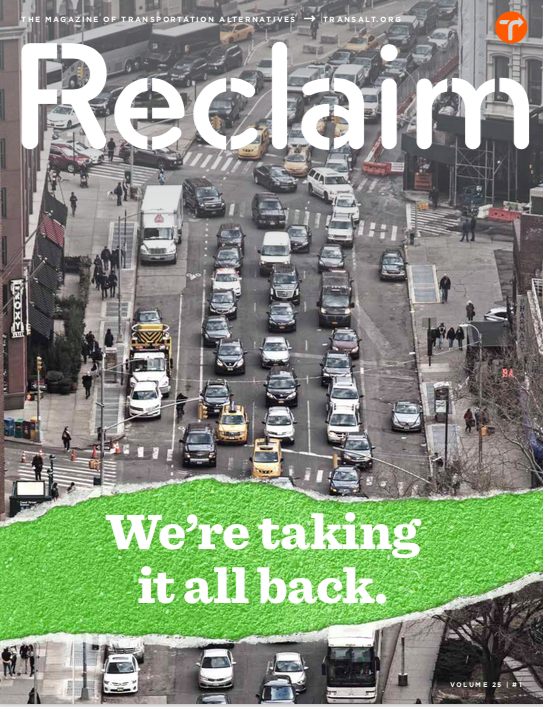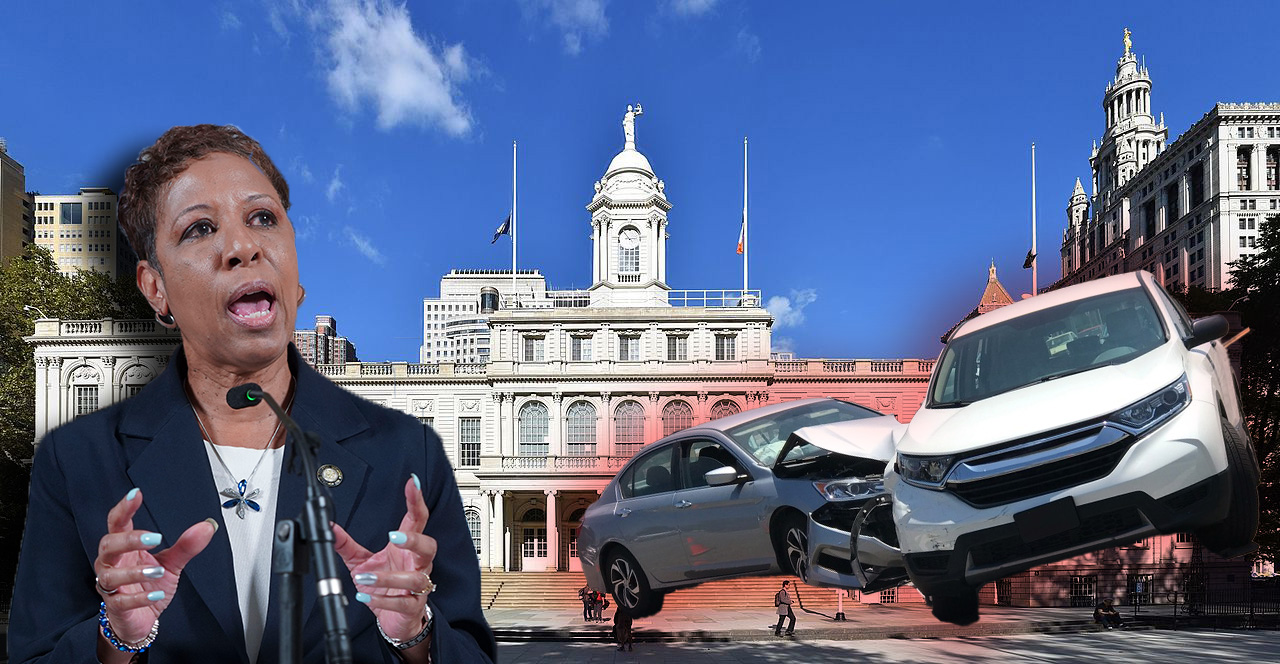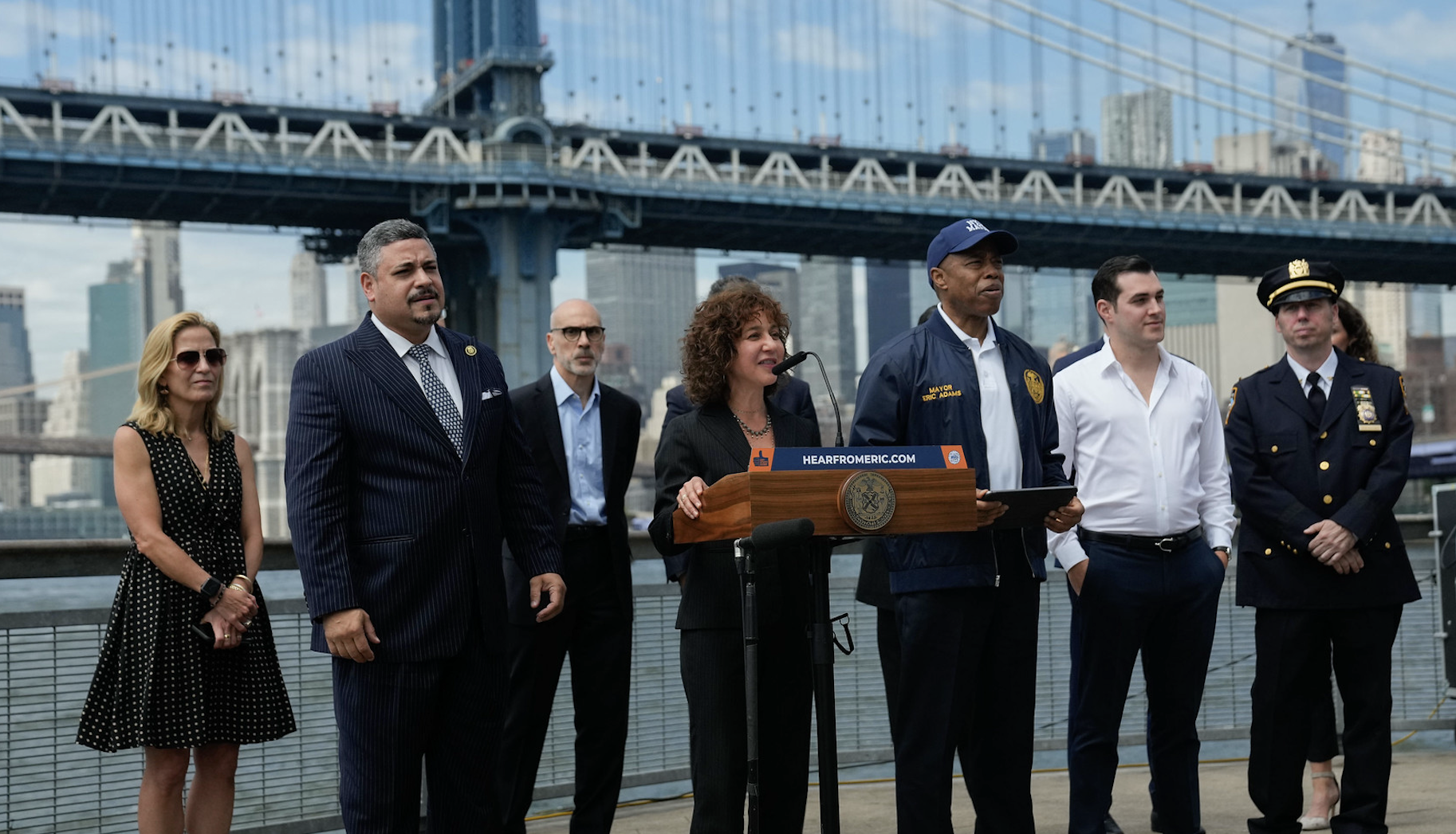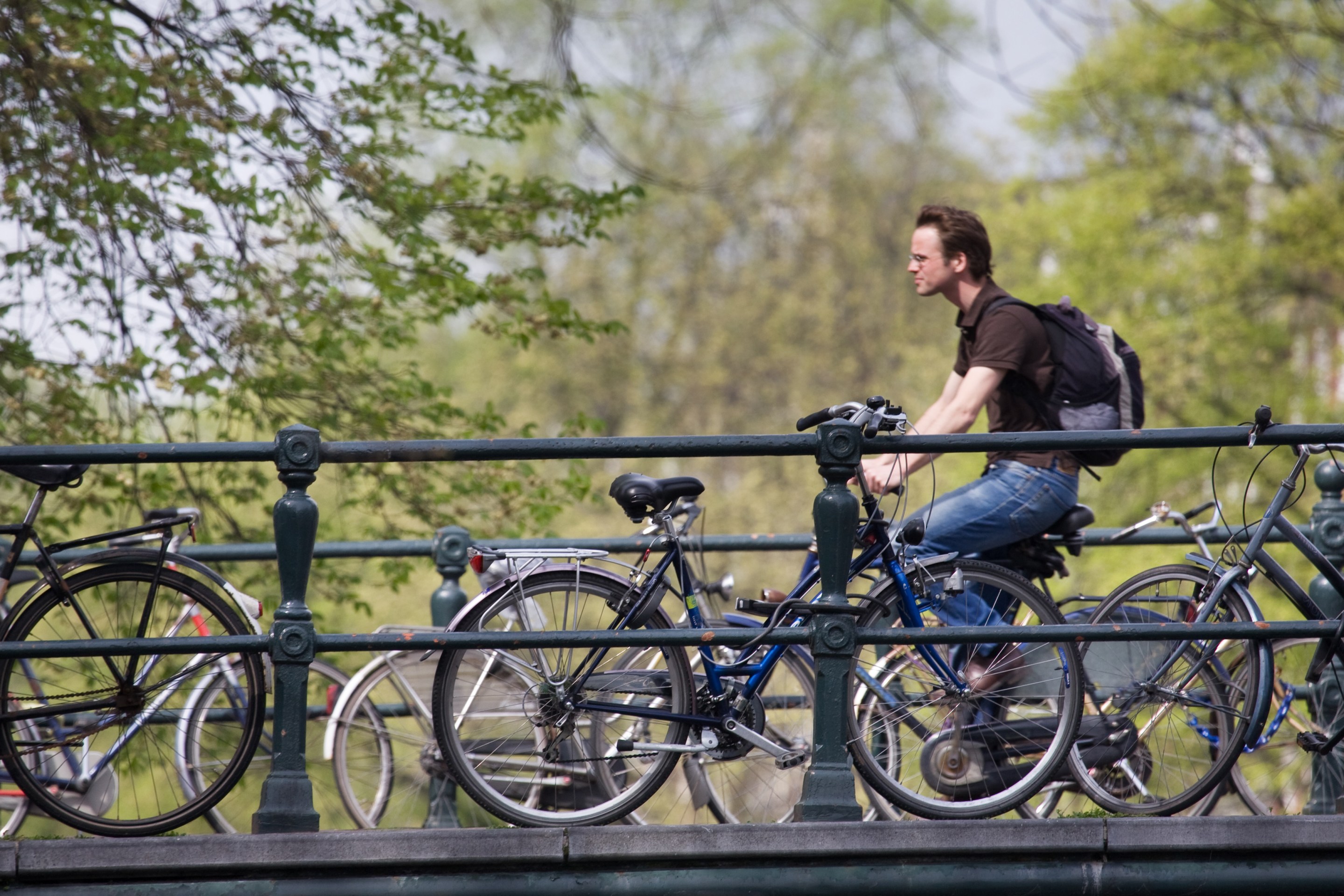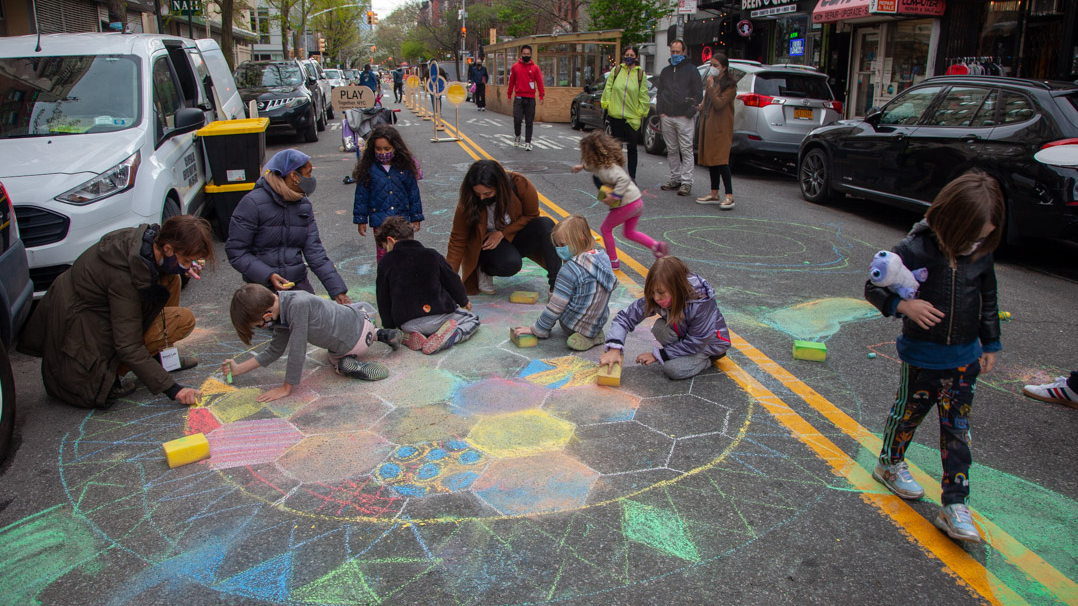This is a sneak-peak at the new issue of Reclaim, the in-house magazine of Transportation Alternatives. All TransAlt member get a free subscription to Reclaim magazine — join at transalt.org/membership.
It is a Friday afternoon in early spring and the East Elmhurst District Office of State Senator Jessica Ramos is positively buzzing. Constituents are stopping by for free tax preparation by a group of CPAs downstairs. The staff — most of whom live in the district — are packing up: cases of bottled water, paper plates, a public address system, a podium. Tonight will be Senator Ramos’ first community town hall since she took office on a wave of popular support at the end of last year.
Someone calls excitedly across the room, “Hey, we got the Women’s History Month pamphlets!” A “woop-woop” can be heard back. The trifolds get placed on a crowded table at the front of the room, near take-home copies of the Constitution and a stack of #FixTheSubway surveys for straphangers. A sign above the surveys explains that increasing resources for public transportation is the key issue in the 2019 budget and Senator Ramos wants to hear from passengers. “Comparte porque es tan importante arreglar el subway,” it reads. “Share because it is so important to fix the subway.” On the wall, a framed poster lists ways to build community: leave your house, know your neighbors, dance in the street, help carry something heavy, hire young people for odd jobs, know that no one is silent though many are not heard?—?work to change this.
A few months ago, Jessica Ramos, a former aide to Mayor de Blasio, rose to power in an insurgent campaign to beat four-term incumbent State Senator Jose Peralta, a member of the Independent Democratic Conference, for control of District 13, which covers Corona, Elmhurst, Jackson Height, and areas of Astoria and Woodside. She secured the mayor’s endorsement, along with nods from Senator Kirsten Gillibrand and The New York Times, and won the election by a whopping ten percent margin.
After sitting down with Reclaim, Senator Ramos rushed to P.S. 149, where she hosted a hundred of her Queens constituents in the school auditorium. She was there to let them know what has been going on in Albany, and to hear their questions about the state of the district. The following interview concluded on foot, on the way to that community town hall, which is how Senator Ramos — a proud pedestrian — almost always gets around.
You grew up in your district. How has the state of transportation changed?
Having been born in 1985, I have vague memories of what the MTA used to look like in the '80s. I have a really cool picture of my mom and dad and older sister and me on a train full of graffiti. I have recollections of that, but it was nothing like the state of the trains now. Trains are really in disrepair and it’s become quite dangerous. The wheels on the 7 train often have to be replaced because they have eroded over time, which has resulted in some derailments. Not too long ago a car was impaled underneath the 7 train by falling debris. Last summer, I remember during the campaign, a stone piece of the aqueduct over Queens Boulevard also fell. Luckily it didn’t hit a car or anybody, but it very well could have killed someone.
My mom doesn’t have a driver’s license and always took public transportation, so the MTA has been a part of my entire life. The state of the trains now are very different than the ones that I grew up with. I can even anecdotally say that it was much more reliable because in high school I had this boyfriend who went to John Bowne in Flushing, and I went to the Academy of American Studies in Long Island City. After school sometimes we would meet at the Roosevelt Avenue Station because it was halfway. I actually once timed it, so I know for a fact that the E train from Queensboro Plaza to Roosevelt Avenue used to take about seven minutes. I don’t think the E train has taken seven minutes from Queensboro Plaza to Roosevelt Avenue since.
I used to take the Q101 bus to high school every day because of where I lived. It was really convenient to go down Steinway Street into Long Island City, and it was a reliable mode of transportation. It didn’t take very long. But now, waiting for buses takes a long time. Because there are so many cars on the street, because congestion is a real thing, of course, it takes longer for buses to travel from stop to stop, too.
On the plus side, bike lanes are a huge difference between when I was growing up and now. We didn’t have any bike lanes at all, not that I remember, when I was a little girl.
Now that you are in Albany all week, how are you getting around?
Well, I don’t. In Albany, I am stuck in two buildings the entire day, every day. I have not figured out the bus system so that I can get from my apartment to the State Capitol. Usually State Senator Biaggi drives; she is one of my roommates. Or else I call a cab. Especially now that it’s starting to get warmer and the snow has melted all the way, maybe I will bring up a bicycle.
Like my mom, I don’t have a driver’s license. I don’t know how to drive. Now that I’m going between New York City and Albany a lot, I sometimes think about learning. But in reality taking Amtrak is not that bad and allows me to read, catch up on emails and phone calls, which I wouldn’t be able to do if I was driving. Besides, the Amtrak trip is pretty. It’s beautiful. New York is a beautiful place.
Your district may be up for the next round of bike share expansions. Do you think the streets are ready for it?
We need more bike lanes. It is really important we protect the safety of all bicycle riders, whether it’s people who are commuting, people who are exercising, or people who are delivery workers. It’s no coincidence that Manhattan has plenty of bike lanes, and my district, which is a very diverse district, with a lot of immigrants and undocumented people who use bikes to get around, is long overdue for more bike lanes. It is actually a real economic justice issue.
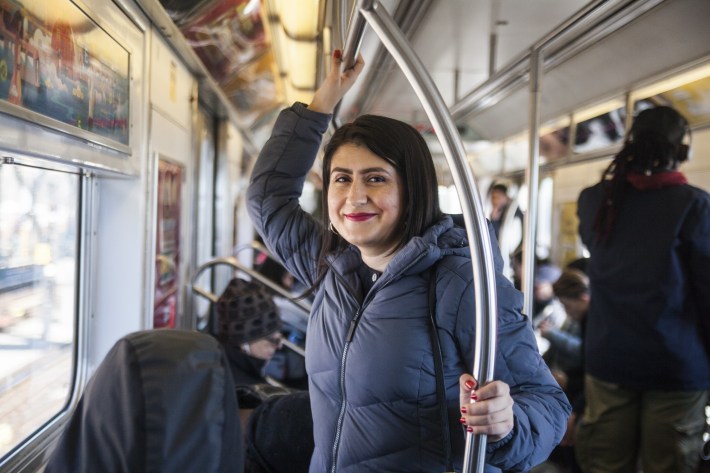
How do you feel about Mayor Bill de Blasio’s crackdown on food delivery workers who use e-bikes?
I very much support the legalization of e-bikes. In my district, there are a lot of delivery workers, especially older ones who can’t necessarily pedal, especially through inclement weather. They use e-bikes, and for them it’s a matter of survival. This is what they use to earn a living. Especially in the age of apps, where we expect certain delivery times, the e-bike seems like the most efficient mode of transportation. I know that there are some cyclists who have some concerns about sharing the lane with e-bikes. In order to make it work, it is important for us to create a space for them, going back to bike lanes and such. That’s the next level of conversation that we need to have, but as of right now, it’s important to ensure that people can use e-bikes in a way that they are not penalized. The city likes to say that they are really punishing the restaurants but we all know it falls on the delivery worker.
TransAlt has identified Northern Boulevard as a new “Boulevard of Death.” What needs to be done? What’s the hold-up?
The hold-up is just government bureaucracy. I’ve certainly been having conversations with the Department of Transportation at both the city and state levels. Before anything else, we need to engage all of the communities that depend on Northern Boulevard, especially those who use different modes of transportation. What is important here is most especially the schools on or near Northern Boulevard. There are approximately 12,000 students who have to cross Northern Boulevard twice a day, and we have three more public schools coming. Crosswalk safety is very important. Since 2012, we have lost six children. If I’m not mistaken, in all cases it was the driver’s failure to yield to the pedestrian as they were crossing the street in the crosswalk with the right of way. This is something that is very troubling for me as a mother. My youngest takes piano lessons on Northern Boulevard, and I constantly have to look over my shoulder and position myself so that I am on the side of the oncoming cars, make sure that he is right with me or in front of me so a car cannot clip him. These are all things that we need to think about.
There are several different ways that we can redesign Northern Boulevard. It is unfortunate that it is technically a highway, and that makes people think that they can speed. It is important that we are utilizing all of our resources to do it right, because it is such a highly trafficked boulevard. It is a lot of cars, it is a lot of pedestrians, it is a lot of restaurants and a lively thoroughfare for our local economy that we want people to be able to enjoy in a safe way.
In general, in the city, because there is so much traffic, that results in a lot of road rage, which results in a lot of speeding and overly aggressive driving. Everybody of course is in a hurry because there’s so much traffic. Our roads were not built for this amount of car traffic. In general, car culture is something that we need to start rethinking as a society as a whole, because we do need better.
It’s rare to hear a state official speak so frankly about the problems of car culture. Where does that interest come from?
It’s inherent. I have always had a fascination with the way government interacts with people, and how good government should interact with people, but I cannot point to anything that has happened to me or some sort of epiphany. I am naturally an urban person. I love that I am from New York City and I love that I am from Queens, where everybody can find their place and feel welcomed. That leads to me thinking about infrastructure and how we are utilizing our space because it is so limited — and we are expecting our population to increase, not decrease.
In general, when it comes to urban planning, I have often thought about how we are best utilizing space, how much space we actually give to cars, and who the streets are for. Are the streets for us? Are they really meant to facilitate the comings and goings of people locally, or are we encouraging people to sort of travel through and beyond? This is at the intersection of transportation and labor, how much energy people have to spend to commute to work and how dependent we are as a whole on public transportation. We do not have a reliable public transportation system where people can get around and not be late for work, for which they’re often penalized. If you are someone who is paid by the hour, that certainly cuts into your paycheck and for many families, especially here in Queens, that is a real struggle.
If the goal is fewer cars, how do we get there?
That is always the chicken and the egg. We want fewer cars but we are never going to achieve having fewer cars if our public transportation is not reliable, and public transportation is not going to necessarily be reliable if so many people continue to drive. It is a changing culture, for sure. Beyond passing congestion pricing and other policy initiatives, it is also about utilizing this moment to have that conversation with our neighbors. Here in my district, of course, we have a very high immigrant population, and oftentimes they see the purchase of a car as a sort of milestone to the American dream. They were able to save up for that car, but if we can help them see if they really need the car, the answer is very often no. They are perfectly able to walk to the train station and get around that way. And it is healthier for our community because of all of the emissions that come out of cars that are polluting our air. But it is part of a certain culture, and change is a matter of education that we do as advocates and as legislators. The government should be part of that education as well, and the Vision Zero campaign has helped lead the conversation in the right way. We do need people to drive less.
As recently as a few years ago, encouragement to drive less was not something we heard much of from elected officials.
Why not? There are people who need to drive and there are people who do not need to drive. There are senior citizens and people with disabilities for whom it is really their only mode of transportation. It is very hard, especially given the lack of accessibility in our transportation system. But even these cases are more of an argument for just getting more cars off the streets so that the traffic can flow a lot easier. Addressing transportation deserts is part of the solution, especially in Queens, so that eastern Queens can enjoy public transportation. In districts like mine, where we have the E, F, M, R, 7, and then one station of the N and W in Astoria, it is easier for us to make the argument to please take public transportation if you can. It’s much harder to make that argument everywhere else. But I think that is what our part in this district is. Our role in helping the situation is ensuring that, at the very least, we are taking public transportation. I continuously encourage people to drive less. We need to exercise so it is good to walk around and enjoy the neighborhood, and it builds community, and that is really important.
What is your big vision for transportation in New York City?
For starters, I would want a world-class transit system. We are New York City — I should say, we are New York fucking City — and we should be leading the world with state-of-the-art technology. But that is the cocky New Yorker in me. And because we are one of the richest places on earth, that is not a pipe dream. If only we could get those darn rich people to pay their fair share and understand that they are not going to continue to be able to make a profit if all their workers are late all the time, and that they would actually benefit by investing in our public infrastructure.
I would like to see an MTA that really does connect the boroughs, and decentralizes Manhattan to put us much more on par with each other. I should not have to go through Manhattan to get to Brooklyn. I should not have to go through Manhattan to get to the Bronx. Either you pay for a cab, or if you are not able to afford a cab, you are forced to travel for a much longer period of time. That is not equitable.
I would love for the MTA to be a lot more transparent. We need the budget to be open data, with a level of transparency that allows for advocates and academics and much more well-versed thinkers to help us have the best possible system. I am a firm believer in including all stakeholders when it comes to any policy-driven conversation.
There is also a lot of ambiguity around who is in charge of the MTA. We all know it is Andrew Cuomo. He is going to continue to deny it. But obviously when it comes to talking about expanding East-Side Access, when it comes to, you know, cutting the ribbon on the Second Avenue subway, he was certainly there, so he cannot have it both ways. If it needs to be clearer who is in charge, then we should make it clearer.
And the MTA board should have people on it who really truly utilize these services, who ride the train and ride our buses. It was very troubling to me when, several months ago, one of the MTA board members asked exactly how it was that the bus system worked. I mean, come on. Do you even live in New York, sir? It is completely out of whack. I did an event on the MTA with the Tri-State Transportation Campaign and my colleagues Senators Salazar, Biaggi, and Gounardes. The room was packed. Yes, because everybody is worried about the MTA, but actually these were mostly advocates and people who are decently knowledgeable about the system and who really care about working towards having the best possible system. Pick six people out of that room, and they would probably do a much better job on the MTA Board of advocating for riders, for straphangers, and for working class people who need a reliable system.
This is a very good idea. Last question: This interview will be read by tens of thousands of those advocates. Is there anything you would like to say to them?
Keep at it. Seriously, I mean that. If we look at where the movement was even five years ago, not that long ago, we are in a very different place today — not just because the public transportation system is increasingly unreliable, but because our message about transportation justice is really resonating with people.

